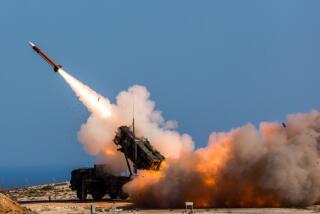Peacekeeper Added to Nuclear Missiles; Arsenal Now at 10
- Share via
WASHINGTON — The Air Force has declared its first 10 MX nuclear missiles operational, marking the first time in 16 years that the United States has added an intercontinental ballistic missile to its land-based arsenal, the Pentagon said today.
“The Air Force achieved initial operational capability for the Peacekeeper missile last night at 9:49 p.m. EST,” said Robert Sims, the Pentagon’s chief spokesman.
“They did this within cost and on schedule. The Air Force now has 10 Peacekeeper missiles on alert on the plains of southeastern Wyoming near Francis E. Warren Air Force Base.
“The nation’s newest ICBM is significantly advanced over the existing Minuteman missile in range, accuracy and payload, and it is the first new ICBM since the Minuteman III in 1970.”
Began in the Fall
The Air Force has been installing the first batch of MX missiles--dubbed the Peacekeeper by the Reagan Administration--at Warren since last fall. Under Air Force procedures, however, 10 of the missiles had to be installed and brought up to full alert for the service to declare the new weapon operational.
The 10 missiles now installed in Wyoming are equipped with 10 nuclear warheads each and are poised for launch in the event of war, Sims said.
Congress has so far authorized the deployment of 50 of the giant MX missiles. That first group of 50 is being installed in refurbished Minuteman III silos.
Last Friday, the Administration announced that it will ask Congress to authorize deployment of another 50 MX missiles by building them for launch from railway cars. Making the missile mobile is viewed by the President as a means of overcoming congressional concerns about the missile’s survivability.
Largest on Land
The MX is the largest land-based missile ever deployed by the United States. The land-based arsenal is composed of Minuteman missiles, the largest of which carries three warheads.
A four-stage missile, the MX stands 71 feet tall and weighs about 195,000 pounds with its 10 warheads. The Air Force expects to complete the deployment of the first 50 of the missiles by 1988.
In another announcement today, the Pentagon said Defense Secretary Caspar W. Weinberger will authorize the Navy to request money next year to begin construction of two additional nuclear-powered aircraft carriers.
The two new carriers would be completed in 1995 and 1998 at a projected cost of about $6.9 billion and would replace two World War II carriers that are still in service.
The decision was unexpected because of the current fiscal mood on Capitol Hill, where Congress has been slashing the Administration’s recent Pentagon budget requests.
According to Sims, the Navy has been authorized by Weinberger to request $600 million in fiscal 1988 and $800 million in fiscal 1989 to begin purchasing components for the new ships.
The Navy intends to sign a single contract covering both vessels in hopes of saving money, Sims said.
More to Read
Sign up for Essential California
The most important California stories and recommendations in your inbox every morning.
You may occasionally receive promotional content from the Los Angeles Times.










